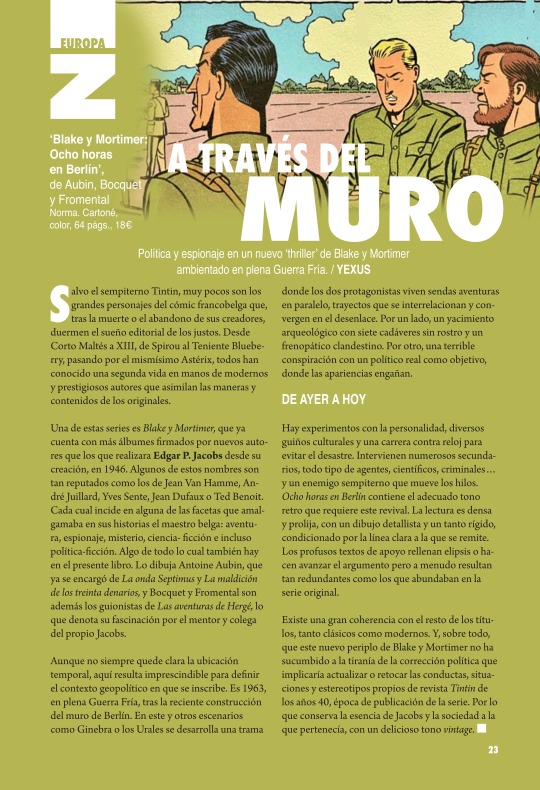#Jean-Louis Froment
Text
Blake et Mortimer: L'Art de la guerre
Aujourd'hui sur Blog à part – Blake et Mortimer: L'Art de la Guerre
Alors que Blake et Mortimer sont à New York, un individu vient vandaliser une stèle égyptienne. C'est le point de départ de L'Art de la guerre.
#aventures #bd #ligneclaire

View On WordPress
#Blake et Mortimer#Edgar P. Jacobs#Floc&039;h#Jean-Luc Fromental#José-Louis Bocquet#ligne claire#New York
6 notes
·
View notes
Text
Mais novidades da ASA em novembro
Mais novidades da ASA em novembro #yann #romainhugault #blakeemortimer #joselouisbocquet #jeanlucformental #antoineaubin
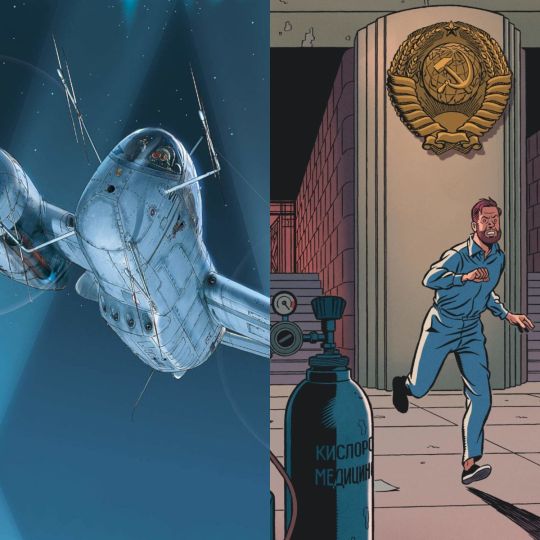
View On WordPress
#Antoine Aubin#Asa#BD franco-belga#Blake e Mortimer#Edgar P. Jacobs#Éditions Blake et Mortimer#França#Jean-Luc Fromental#José-Louis Bocquet#O Grão-Duque#Paquet#Romain Hugault#Suíça#Yann
6 notes
·
View notes
Text



Blake and Mortimer: Eight Hours in Berlin
by José-Louis Bocquet; Jean-Luc Fromental; Antoine Aubin and Laurence Croix
Cinebook
18 notes
·
View notes
Text
Andrea del Sarto
Daniel-Jean-Yves Lesur detto Daniel-Lesur (19 novembre 1908 - 2002): Andrea del Sarto, poema sinfonico (1949). Orchestre philharmonique du Luxembourg, dir. Louis de Froment.
Al pittore fiorentino Daniel-Lesur dedicò altre composizioni: musiche di scena (1947) per il dramma di Alfred de Musset, e un’opera in 2 atti (1961-68, rappresentata all’Opéra di Marsiglia il 24 gennaio 1969); ecco un…
youtube
View On WordPress
#Alfred de Musset#Andrea del Sarto#Daniel-Lesur#Louis de Froment#Orchestre Philharmonique du Luxembourg#Youtube
0 notes
Text
BILAN CULTUREL - NOV+DEC. 2022
Cinéma :
Close - Lukas Dhont
Eo - Jerzy Skolimowski
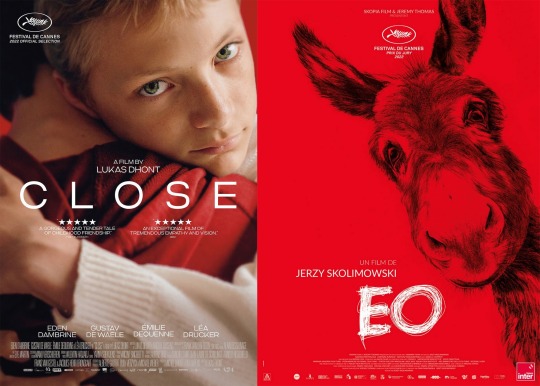
Livres & bandes dessinées :
Les Mystères de Larispem, tome 3 - Lucie Pierrat-Pajot
Hex - Thomas Olde Heuvelt
L’autre moitié de soi - Brit Bennett
Stone Butch Blues - Leslie Feinberg
Tea Rooms - Luisa Carnés
L’Été Diabolik - Thierry Smolderen, Alexandre Clerisse
Chroniques de Jérusalem - Guy Delisle
Une année sans Chtulhu - Thierry Smolderen, Alexandre Clerisse
Spa - Erik Svetoft
Blake & Mortimer : Le Cri du Moloch - Jean Dufaux, Christian Cailleaux, Étienne Schréder
Blake & Mortimer : Le Dernier Espadon - Jean Van Hamme, Teun Berserik, Peter Van Dongen
Blake & Mortimer : Le Dernier Pharaon - Thomas Gunzig, François Schuiten,
Les vieux fourneaux, tomes 5 à 7 - Wilfrid Lupano, Paul Cauuet
Les sœurs Fox (2 tomes) - Philippe Charlot, Grégory Charlet
Tant pis pour l’amour, ou comment j’ai survécu à un manipulateur - Sophie Lambda
Le Singe de Hartlepool - Wilfrid Lupano, Jérémie Moreau
Neptune, tome 2 - Leo
Blake & Mortimer : Huit heures à Berlin - José-Louis Bocquet, Jean-Luc Fromental, Antoine Aubin
De cape et de mots - Flore Vesco, Kerascoët
Koko n’aime pas le capitalisme et autres histoires - tienstiens


Expos :
Tintin, l’aventure immersive - Atelier des Lumières, Paris
Exposition vidéo numérique et poétique - Friche la Belle de Mai, Marseille
Biennale des imaginaires numériques - Friche la Belle de Mai, Marseille

Concerts :
General Elektriks - La Maroquinerie, Paris

Jeux vidéo :
The House of Da Vinci 2 - Blue Brain Games
Spiritfarer - Thunder Lotus Games
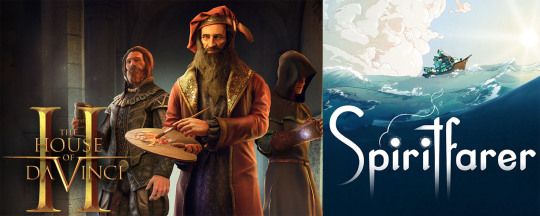
Projections privées :
The Princess Bride - Rob Reiner
Scare Me - Josh Ruben
Hidden (court-métrage) - Jafar Panahi
Valérian et la cité des mille planètes - Luc Besson
Enola Holmes 2 - Harry Bradbeer
Glass Onion : A Knives Out Mystery - Rian Johnson
Swiss Army Man - Daniels
Bound - The Wachowski Sisters
The Handmaid’s Tale, saison 5 - Bruce Miller
Only Murders In The Building, saison 2 - Steve Martin, John Hoffman
Station Eleven, saison 1 - Patrick Somerville
Mercredi, saison 1 - Alfred Gough, Miles Millar
Chair Tendre, saison 1 - Yaël Langmann
His Dark Materials, saison 3 - Philip Pullman
Le Cabinet de curiosités de Guillermo del Toro, saison 1 - Guillermo del Toro


Découvertes musicales récentes :
youtube
youtube
( Requin Chagrin - Crush (ft. Anaïs Demoustier) / Chicks On Speed - Wordy Rappinghood )
0 notes
Text
Blake & Mortimer, tome 29
Blake & Mortimer, tome 29
Huit heures à Berlin
José Louis Bocquet – Jean-Luc Fromental – Antoine Aubin
La présentation du tome 29 de Blake & Mortimer est la dernière chronique de l’année 2022 du blog. Capitaine Blake, directeur du MI 5, et Professeur Philip Mortimer, le scientifique, archéologue amateur, se retrouvent sous la plume de nouveaux auteurs, pour la première fois.
José-Louis Bocquet, ex-directeur de la…

View On WordPress
#Années 60#Aventure#Bande dessinée#BD#Berlin#Billet littéraire#Chronique littéraire#Chronique livre#Chroniques littéraires#Espionnage#Guerre#histoire#Histoire contemporaine#Histoire du monde#Histoire du XXè s#Littérature contemporaine#littérature française#Littérature francaise#Litterature contemporaine#polars#Politique#romans policiers#Russie
1 note
·
View note
Photo
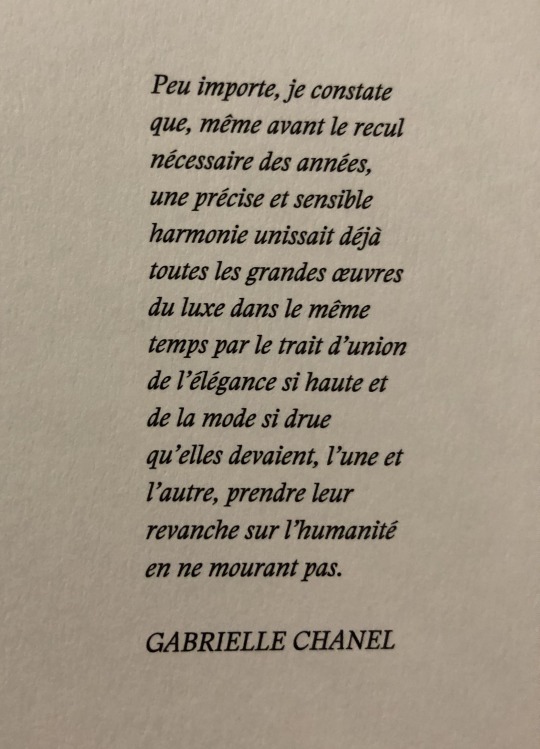
Le Livre "Culture Chanel - The woman who reads" par Jean-Louis Froment.
(© Sous Ecstasy)
#quote#quotation#citation#quotes#livre#book#book lover#bibliophile#book therapy#book addict#book community#book worm#goodreads#culture chanel#Jean-Louis Froment#Gabrielle Chanel#sous ecstasy#sous#élégance#mode
11 notes
·
View notes
Text
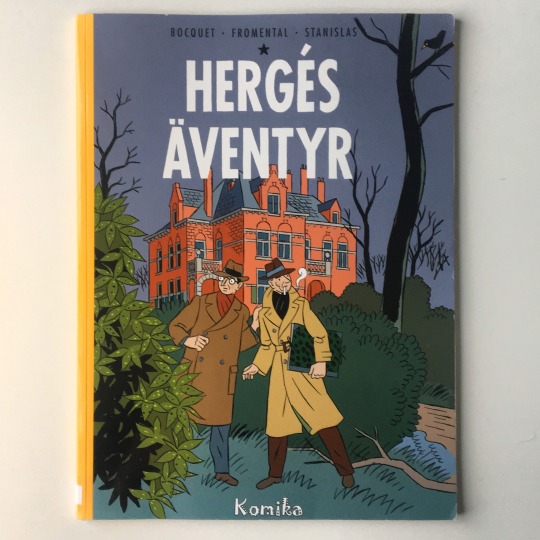
José-Louis Bocquet, Jean-Luc Fromental & Stanislas Barthélemy: Hergés äventyr (1999)
0 notes
Text
50 New Operas In 2021, By The Numbers
So, uh, yeah. 50 operas through May 2, 2021. By comparison: in the entire year of 2020, I experienced 52 new-to-me operas. We’re barely a third of the way through 2021 and I’ve already almost matched that.
Some Stats:
Video vs. Audio:
Video: 40
Audio: 10
Breakdown by language:
French: 25
Italian: 12
English: 2
German: 6
Russian: 4
Danish: 1
Breakdown by century of premiere:
17th: 3
18th: 4
19th: 28
20th: 14
Multiple centuries: 1 (17th, 18th, and 21st centuries for The Secret Life of Paintings because of the issue of the music’s original premieres versus the premiere of this)
Operas by first-time-for-me composers vs. not:
First time: 24 (by 23 composers)
Not: 25 (by 16 composers)
In between: 1 (The Secret Life of Paintings contains music by Vivaldi, and I have never seen any of his operas, but I have seen both Handel and Monteverdi operas)
Total: 50 operas by 40 composers
Adam, Adolphe*
Le postillon de Lonjumeau (The Postilion of Lonjumeau)
Alfano, Franco*
Cyrano de Bergerac
Auber, Daniel François Esprit*
Fra Diavolo (Brother Diavolo)
Gustave III, ou le bal masqué (Gustave III, or The Masked Ball)*
Borodin, Alexander*
Knyaz Igor (Prince Igor)
Busoni, Ferruccio*
Doktor Faust (Doctor Faust)
Caccini, Francesca*
La liberazione di Ruggiero dall’isola d’Alcina (The Liberation of Ruggiero from Alcina’s Island)*
Chabrier, Emmanuel*
L’étoile (The Star)
Charpentier, Gustave*
Louise
Donizetti, Gaetano
Poliuto
Dukas, Paul*
Ariane et Barbe-bleue (Ariadne and Bluebeard)
von Flotow, Friedrich*
Martha, oder Der Markt zu Richmond (Martha, or The Market at Richmond)
Godard, Benjamin*
Dante*
Gounod, Charles François
La colombe (The Dove)*
Grétry, André*
Richard Cœur-de-lion (Richard the Lionheart)
Hahn, Reynaldo*
Ô mon bel inconnu (Oh, my beautiful unknown one)*
Halévy, Fromental
La reine de Chypre (The Queen of Cyprus)*
Handel, George Frideric
Rodelinda, regina de’Longobardi (Rodelinda, Queen of the Lombards)
Semele
Hervé (real name: Louis Auguste Florimond Ronger)*
Mam’zelle Nitouche
Korngold, Erich Wolfgang
Das Wunder der Heliane (The Miracle of Heliane)
Lortzing, Albert*
Zar und Zimmermann (Czar and Carpenter)
Lully, Jean-Baptiste*
Armide
Massenet, Jules
Don César de Bazan*
Don Quichotte (Don Quixote)
Le jongleur de Notre-Dame (The Juggler of Our Lady)
Sapho*
Meyerbeer, Giacomo
L’étoile du nord (The North Star)
Monteverdi, Claudio
L’Orfeo (Orpheus)
Nielsen, Carl*
Maskarade (Masquerade)
Offenbach, Jacques
La belle Hélène (The Beautiful Helen)
La vie parisienne (The Parisian Life)
Pergolesi, Giovanni Battista*
La serva padrona (The Servant Girl Turned Mistress)
Prokofiev, Sergei
Igrok (The Gambler)
Ravel, Maurice*
L’heure espagnole (The Spanish Hour)
Reynolds, Peter*
Sands of Time*
Rossini, Gioachino
La gazza ladra (The Thieving Magpie)
L’Italiana in Algeri (The Italian Woman in Algiers)
Saariaho, Kaija*
L’amour de loin (Love from Afar)- #50!!! (May 2, 2021)
Saint-Saëns, Camille
Henry VIII
Le timbre d’argent (The Silver Bell)*
Tchaikovsky, Pyotr Ilyich
Orleanskaja deva (The Maid of Orléans)
Pikovaya dama (Pique Dame/The Queen of Spades)
Various Composers
The Secret Life of Paintings (pastiche of excerpts from operas by George Frideric Handel, Claudio Monteverdi, and Antonio Vivaldi)
Verdi, Giuseppe
Giovanna d’Arco (Joan of Arc)
Oberto
Wagner, Richard
Der fliegende Holländer (The Flying Dutchman)
Parsifal
Wolf-Ferrari, Ermanno*
Il segreto di Susanna (Susanna’s Secret)
Zandonai, Riccardo*
Francesca da Rimini
Here’s to the next fifty!
8 notes
·
View notes
Photo

Constance-Caroline Lefebvre, sometimes spelled Lefèvre, (born 21 December 1828 in Paris, France; died 1905) was a French opera singer described as a mezzo-soprano and as a soprano. She started her career in 1849 and performed until her retirement in 1866, mostly playing "dugazon" roles. She married her stage partner, famous baritone and composer Jean-Baptiste Faure, in 1859.Lefebvre's early education took place in the Conservatoire de Paris under the guidance of David Banderali for her voice training and Théodore-François Moreau-Sainti for her opéra comique training, both in which she would win first prizes. Lefebvre debuted at the Opéra-Comique on 12 October 1849 as Carlo Broschi in La part du diable by Daniel Auber.[1] Her following roles were often labeled as mezzo-soprano "dugazon" roles, including Le Toréador et Le Postillon de Lonjumeau by Adolphe Adam (Madeleine); Joconde and Jeannot et Colin by Nicolas Isouard (Jeannette); Joseph en Égypte by Étienne Méhul (Benjamin); Le Pré-aux-clercs by Ferdinand Hérold (Isabelle); Le Petit Chaperon rouge by François-Adrien Boieldieu (Rose d'amour); L'Épreuve villageoise (Denise) by André Grétry; Fra Diavolo (Zerline), La Sirène and Haydée by Daniel Auber; and especially Fromental Halévy's operas, Les Mousquetaires de la reine (Berthe de Simiane), La Dame de pique, Le Val d'Andorre, and La Fée aux roses.Throughout the 1850s, Lefebvre's career was marked by the creation of many roles. In 1850, she created Palomita in La Chanteuse voilée by Victor Massé and another role in Les Porcherons by Albert Grisar; in 1852, she created La Croix de Marie by Louis-Aimé Maillard and Madelon by François Bazin, followed by the titular role in Colette by Justin Cadaux in 1853. In 1854, she created Prascovia in L'Étoile du Nord by Giacomo Meyerbeer and then Massé's Miss Fauvette, Grisar's Le Chien du jardinier, and Rosette in Adam's Le Housard de Berchini in 1855. She created three roles in operas by Ambroise Thomas: Le Songe d'une nuit d'été in 1850, Stella in Raymond ou le Secret de la reine in 1851, and Psyché in 1857.
5 notes
·
View notes
Text
Blake et Mortimer: Huit heures à Berlin
Aujourd'hui sur Blog à part – Blake et Mortimer: Huit heures à Berlin
Alors que Mortimer part en Union soviétique, Blake va en Suisse pour une réunion ultra-secrète. Tous les deux se retrouveront pour Huit heures à Berlin.
#espionnage #bd

View On WordPress
#Antoine Aubin#Blake et Mortimer#espionnage#Jean-Luc Fromental#José-Louis Bocquet#Planète SF#science-fiction
2 notes
·
View notes
Text
The Aix Annunciation mysteries
A bit of 🎨 and 😈 today!
Emile Henriot, a french writer, reported - or came up with - a strange gossip about The Aix Annunciation in his novel 𝘓𝘦 𝘥𝘪𝘢𝘣𝘭𝘦 𝘢̀ 𝘭’𝘩𝘰̂𝘵𝘦𝘭 (1919) : this sacrilege painting has been designed with satanic intentions (and even painted backwards in some versions!).

🕵️♀️ Some facts:
The triptych is attributed to Barthélémy d’Eyck. It was commissioned in 1442 by Pierre Corpici, a local cloth merchant, for his chapel’s altar in Saint-Sauveur cathedral in Aix-en-Provence (southern France). It was then divided in 6 pieces, the central panel was moved to the Eglise de la Madeleine, still in Aix, and you can now see it in the Musée du Vieil-Aix.
The annunciation is a very common theme in Christian painting and it had been quite codified through the century, this version may differ a bit from the images we have in mind in the first place, that would explain the fantasies about it. Henriot considered that the painting was unholy in many ways.
First thing, if you zoom on the ray of light, instead of the usual dove symbolizing the Holy Spirit, you’ll see a tiny human holding a cross (the 𝘏𝘰𝘮𝘶𝘯𝘤𝘶𝘭𝘶𝘴, « the little man » in Latin), kind of diving towards the Madonna. It’s probably not the most common representation but it’s not that usual before the Council of Trent forbids this depiction (see the Merode Altarpiece and other medieval paintings for exemple).
Others things that excited the writer’s imagination:
Gabriel’s wings look like they’re made of owl feathers, a bird considered as a bad/unlucky omen.
The light that radiates from God hits the head of a little monkey (crowning the reading desk) before it shines on the Virgin.
Henriot also considers that God’s gesture is « unliturgical », his fingers’ position is obscene.
The expressions on the characters’ faces do not suit a sacred painting.
You can also notice the bats sculpted in the architectural ornements surrounding the Archangel: not suitable as well, according to Henriot.
Even the flowers in the vase are allegedly unholy: Henriot identifies belladonna and aconit, flowers used by witches and other evil creatures. We can also see what looks like digitalis (also known as Virgin’s glove), roses and lilies, which are frequently associated with the Virgin Mary so it’s probably actually no big deal…
The story tells that the patron refused to pay the price they agreed on beforehand. The painter produced a demonic and blasphemous artwork in order to avenge himself and to punish the penny-pincher.
🖼️: 𝘛𝘩𝘦 𝘈𝘪𝘹 𝘈𝘯𝘯𝘶𝘯𝘤𝘪𝘢𝘵𝘪𝘰𝘯 (detail of the central panel), attributed to Barthélémy d’Eyck, 1443-1445, Musée du Vieil-Aix.
📚 Selected sources (in french):
Emile HENRIOT, Le Diable à l’hôtel ou les plaisirs imaginaires, Paris, Emile-Paul Frères, 1919.
Jean-Louis VAUDOYER, Les peintres provençaux : de Nicolas Froment à Paul Cézanne, Paris, La jeune Parque, 1947.
Louis-Philippe MAY, « L’annonciation d’Aix » in Provence Historique, 1954, tome 4, fascicule 16, pp. 82-98.
René ALLEAU (dir.), Guide de la France mystérieuse, Paris, Sand, coll. Les guides noirs, 2005.
3 notes
·
View notes
Text
Is It Possible To Exhibit Architecture?
A few years ago, I was asked by a group of experts surrounding an artist to curate a national pavilion during the Venice Biennial of Architecture.
I don’t remember exactly how the artist had been selected, but I’m sure it was on a democratic basis, and the people around him were all of great quality. Though, I had problems understanding what my role and curatorial tasks could exactly be, as the artist had already written a clear concept and produced detailed drawings for the forthcoming exhibition. My curriculum vitae had probably two interesting points to offer: as a foreigner I would have brought a nice touch of internationalism and, as an architect, a legitimation for an artist to participate to the architecture biennial. Though, being unable to define exactly my position and feeling not really essential, I refused that kind proposal and lost an opportunity to promote myself.
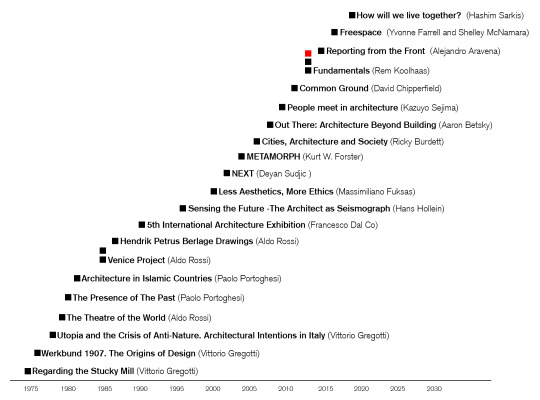
Read also “Moments of Transition”
But the thing that annoyed me most was the questions lifted by the whole story. Why should an artist represent a country during the architecture biennial? Why should a curator be the last participant in such a project? Why, at a time when borders between disciplines are blurred, should we question the links between art and architecture? Each of these questions deserve at least a 300-pagethesis but they should always be in our mind when we visit the Venice Biennial. And I could also add: What is the exact role of an exhibition designer? What are the real powers at play in a time when public institutions are depending more and more from private founding? What does it mean to build temporary structures that will, afterward, only exist as images?
I might sound conservative but I think architecture is here to address social problems, to shape an idea of living and to enlighten its users and visitors. If, on top, in turns into stone the problems and culture of its time, it will become a masterpiece. But, instead of that, Venice gives us too often spatial experiences for VIPs by installing some kind of three-dimensional machinery that pretends to change their perception after two Campari-Spritz and a bunch of small talks (think about the cheap environmental questions, the pseudo-political engagement and the new-age philosophy that surrounds most of Ólafur Elíasson productions).
We all know that exhibiting architecture is a more than difficult task. If I exhibit art, I hang on walls, put in space or install outside the art objects “themselves”. The visitors will come to see the artworks in their reality, they will share their presence at the same time, in the same place. But if I exhibit architecture, I deal with plans, photographs, façades, sections, models. All those things are representations of architecture, not the thing itself. It’s probably why, in 2014, in a more than radical gesture, Rem Koolhaas decided to reduce architecture to its elements: floor, roof, stairs, window, etc. to be able to exhibit those parts in real, as in a large hardware store. No representations can replace the experience of visiting a building and not all the visitors of an architecture exhibition are able to spend time figuring space looking at two-dimensional drawings. Of course, the last years have seen an increase of 3D models, interactive videos, or Augmented Reality tools. (And even if low-cost flights have democratized trips, one should not overestimate our ability to travel, especially today.) We need architecture exhibitions to address questions and topics, not to experience a pseudo-psychedelic light-show à la Elíasson. Because nothing can replace the smell of freshly oiled wood in the Fisher House by Louis I. Kahn, the violent summer sun over the Barcelona Pavilion in a July afternoon or the welcoming old lady that generously opened her door and shared her life with me in her patio house from Arne Jacobsen in the Berlin-Hansaviertel.
We face a double problem: artists behave like architects by building installations and large-scale projects (without being able to address the real problems of architecture) or architects behave like artists by enjoying the freedom that their everyday business doesn’t allow (without being able to produce a real work of art). That’s probably why, as a matter of fact, a lot of pavilions in Venice turn towards interior design or utopia projects when it comes to exhibit architecture. And those who refuse those strategies simply translate the content of a book into space (with too much text and documentation, a mistake that “elements of architecture”did).

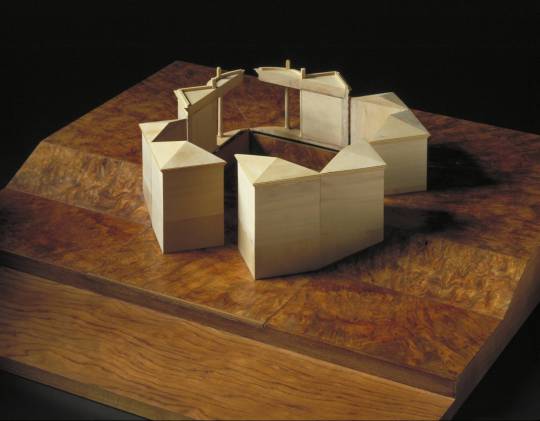



Proposal for the French Pavilion at the XLIV Venice Biennial of Art. | Project © Jean Nouvel, Emmanuel Cattani & Associes; photos © Georges Fessy
If, tomorrow, I was asked to curate a pavilion in the Venice Architecture Biennial, not as the last participant in the project but as the first one generating its concept, I will be confronted by a serious problem. I might then probably use the same strategy as Jean-Louis Froment who, in 1990, invited Jean Nouvel, Philippe Starck and Christian de Portzamparc to propose three projects towards the reconstruction of the French Pavilion. Nouvel conceived a whole scenario that will have lasted four years and, at the end, meant that the building from 1912 by Faust Finzi and Umberto Belloto would have been entirely replaced by his own. It was a brilliant proposal that dealt with architectural regulations (and another “cold case” as it was neverconstructed), and it would be a chance for the contemporary artists to exhibit in a space that fits their actual needs and requirements. If the whole process and concept proposed by Nouvel had something from Gordon Matta-Clark—and therefore of an architect behaving like an artist—the result would have also been a political statement and national symbol: France would own nowadays a brand-new pavilion with up-to-date technique and space, constructed by a contemporary architect. And the architect would have exhibited and done what he is supposed to do: a construction.
***
VAB 03: Thibaut de Ruyter

Photo © Bella Sabirova
Thibaut de Ruyter is a french architect, curator and critic. He has been living and working in Berlin since 2001. His interests are based on new media and their archeology, the relationship between art and architecture, and the artistic scene in post-soviet countries and particularly in Central Asia.
His latest projects are a travelling exhibition for Goethe-Institut in Eastern Europe and Central Asia, Die Grenze (with Inke Arns) who was displayed in 11 cities between 2017 and 2019 while his exhibition A Song for Europe was presented at the V&A, London 2017 and Schauspielhaus, Stuttgart 2018. In 2019, on the occasion of the 100 birthday of the Bauhaus in Germany, he co-curated with Marjolaine Levy the exhibition 26 x Bauhaus that was to be seen in Berlin, Bremen and Munich.
He edited or co-edited the books: Zeitgeist (Archive books, Berlin), Industrial on tour and Industrial Research (Revolver Verlag, Berlin) and Stadtbild (Verbrecher Verlag, Berlin). As an art and architecture critic, he writes or has been writing for the magazines Artpress, Il Giornale dell’Architettura, Fucking Good Art, Frieze d/e, L'Architecture d’Aujourd’hui and Architectuul. In 2015 he co-founded ALUAN, the first Kazakh art magazine, with Gaisha Madanova. He has been a member of the French section of AICA (International Association of Art Critics) since 2008.
1 note
·
View note
Audio
(Jean-Louis Gaillard) La foi d'une mère (1° partie)
Dans des écrits sur la vie de Beate Paulus, la femme d’un serviteur de Dieu allemand, qui vivait en bordure de la Forêt Noire, on trouve plusieurs « incidents » illustrant la puissance d’une foi vivante, et la providence d’un Dieu qui entend les prières.
Malgré une santé médiocre, Beate désirait fermement élever ses enfants, dont cinq de ses fils qui allaient à l’école. Elle se débattait, priait, et travaillait avec peine, non seulement à la maison, mais au dehors, afin de pourvoir à leur nécessaire.
Un jour, peu avant la moisson, les champs étaient fournis, et le blé et le froment étaient serrés. Notre mère avait déjà calculé que leur produit couvrirait tous nos besoins pendant une année entière.
Elle se tenait à la fenêtre, calculant mentalement nos dépenses futures, avec une grande satisfaction, quand soudain, son attention fut attirée par quelques gros nuages noirs se déplaçant et dérivant à toute vitesse dans le ciel d’été…
« C’est une tempête de grêle » s’exclama-t-elle avec épouvante. Et sautant rapidement par la fenêtre, elle sortit. Ses yeux étaient fixés sur une effrayante masse de nuages annonçant une tempête qui approchait furieusement et extrêmement rapidement vers elle, en couvrant tout l’horizon à l’Ouest.
« Oh ! Dieu, s’écria-t-elle, voici qu’une horrible tempête arrive. Que va devenir mon blé ? ».
La masse noire roulait de plus en plus près dans le ciel tandis qu’un mouvement menaçant (qui précède toujours une tempête) commençait à se balancer dans l’air étouffant, et que de terribles grêlons tombaient avec une violence inouïe.
Se tournant pour regarder les champs de blé à l’Est, au fond de la vallée, elle leva les mains vers le ciel, avec anxiété, et s’écria : « Cher Père dans le ciel, que fais-Tu ? Tu sais que je ne peux pas payer la pension de mes fils à l’école, si je n’ai pas le produit de ces champs ! Oh ! Père, étends Ta main toute puissante, et ne laisse pas la grêle ruiner mes espoirs ».
Néanmoins, à peine ces mots sortaient-t-ils de ses lèvres, qu’elle entendit, semble-t-il, comme une voix qui murmurait à son oreille : « Mon bras est-il trop court qu’il ne puisse t’aider dans ces circonstances ? »
Décontenancée, elle alla se retirer dans un coin tranquille de la maison, et là, supplia Dieu de lui pardonner son manque de foi.
Pendant ce temps, la tempête était passée les différents voisins criaient, hurlaient que toute la vallée était recouverte d’un épais tapis de grêlons énormes, jusqu’à la bordure de nos propres champs, qui avaient été totalement épargnés.
La tempête avait atteint la limite des champs, et soudain, elle avait pris une autre direction, dans la vallée voisine. Bien plus tard, tout le village émerveillé, s'exclamait que Dieu avait fait un miracle pour sauver notre mère, car Il l’aimait. Elle, écoutait, silencieuse, adorant la bonté du Seigneur, et faisant vœu d'avoir davantage confiance en Lui seul, désormais.
1 note
·
View note
Text
Sinfonia di danze
Daniel-Lesur (nome d'arte di Daniel-Jean-Yves Lesur; 19 novembre 1908 - 2002): Symphonie de danses per archi, timpani e pianoforte (1958). Orchestre National de l’ORTF, dir. Louis de Froment (dal vivo, 1965).
youtube
View On WordPress
0 notes
